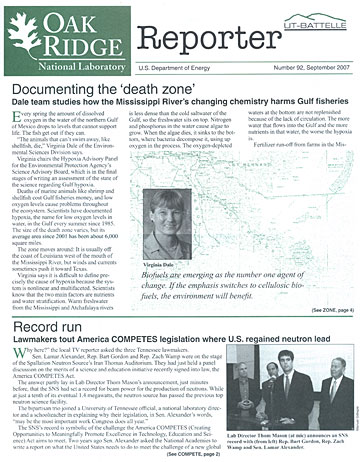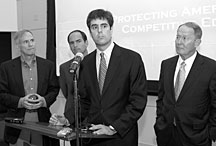 |
Number 92, September 2007 |
 Documenting the ‘death zone’
Documenting the ‘death zone’
Dale team studies how the Mississippi River’s changing chemistry harms Gulf fisheries
|
|
Biofuels are emerging as the number one agent of change. If the emphasis switches to cellulosic biofuels, the environment will benefit. |
Every spring the amount of dissolved oxygen in the water of the northern Gulf of Mexico drops to levels that cannot support life. The fish get out if they can.
|
|
Virginia Dale |
“The animals that can’t swim away, like shellfish, die,” Virginia Dale of the Environmental Sciences Division says.
Virginia chairs the Hypoxia Advisory Panel for the Environmental Protection Agency’s Science Advisory Board, which is in the final stages of writing an assessment of the state of the science regarding Gulf hypoxia.
Deaths of marine animals like shrimp and shellfish cost Gulf fisheries money, and low oxygen levels cause problems throughout the ecosystem. Scientists have documented hypoxia, the name for low oxygen levels in water, in the Gulf every summer since 1985. The size of the death zone varies, but its average area since 2001 has been about 6,000 square miles.
The zone moves around: It is usually off the coast of Louisiana west of the mouth of the Mississippi River, but winds and currents sometimes push it toward Texas.
Virginia says it is difficult to define precisely the cause of hypoxia because the system is nonlinear and multifaceted. Scientists know that the two main factors are nutrients and water stratification. Warm freshwater from the Mississippi and Atchafalaya rivers is less dense than the cold saltwater of the Gulf, so the freshwater sits on top. Nitrogen and phosphorus in the water cause algae to grow. When the algae dies, it sinks to the bottom, where bacteria decompose it, using up oxygen in the process. The oxygen-depleted waters at the bottom are not replenished because of the lack of circulation. The more water that flows into the Gulf and the more nutrients in that water, the worse the hypoxia is.
Fertilizer run-off from farms in the Mississippi Basin, which drains 41 percent of the U.S. land area, is a major source of nutrients. Initially, scientists thought nitrogen did the most damage, but nitrogen levels have decreased in recent years thanks to precision agriculture, Virginia says, while the hypoxic zone has continued to grow. Phosphorus
levels have increased, however.
“Phosphorus, we’re learning, is going to be more important than we thought,” Virginia says. Scientists talked very little about phosphorus in the original scientific assessment of hypoxia in 2000 because of a lack of data. The new report examines phosphorus’s contribution in-depth and recommends a 45-percent reduction in both phosphorus and nitrogen.
Virginia says the dramatic scales of the Mississippi River basin make it impossible to establish a precise cause and effect relationship between nutrients and hypoxia. Her emphasis is on getting measurements of what is happening between fields and the Gulf and using models at different scales to interpret the data. Understanding these intermediate layers is crucial to filtering out the noise and figuring out how to shrink the hypoxic zone.
Initially Virginia thought remote sensing could be used to reduce the cost of measurements, but she found that water chemistry is tough to measure from a satellite. For data about the intermediate layers, costly monitoring stations are required, so for many watersheds no reliable data are available. Buoys can be used to get point samples, but they are expensive and design of the sampling must be precise because depth and location affect the buoys’ reliability.
Although farmers are using less fertilizer
per acre, Virginia anticipates total fertilizer use to increase because more farmland is being used to grow corn for ethanol production. According to the U.S. Department of Agriculture, farmers planted more acres of corn in 2007 than in any year since 1944. Corn requires more fertilizer than other crops, and farmers now have heavy incentives to grow it.
The panel recommends using cellulosic biofuels—which include ORNL’s switchgrass and poplar hybrids—over growing corn for ethanol. But the corn ethanol technology is already in place while cellulosic biofuels are still years away.
In the meantime, Virginia has a proposed LDRD project for landscape design that will help farmers and land management agencies determine, for example, what places are best for growing corn without damaging the environment or where to put a wetlands so it will trap the most agricultural run-off. In its report to the EPA, the panel recommends planting perennials, promoting environmentally sustainable biofuel production and using no-till farming as key land management strategies. Reducing the amount of nutrients on fields and restoring wetlands are other important parts of the panel’s land management recommendations, Virginia says.
It will be decades, she says, before scientists see statistically significant changes in the size of the zone. The panel targets small and large watersheds as ideal indicators of change because they respond more quickly than the entire system and more accurately than local measurements.
Virginia says biofuels are emerging as the number one agent of change in the system. If the current path of expanding corn-based ethanol production continues, the hypoxic zone in the Gulf will probably continue to grow. But if the emphasis switches to cellulosic biofuels, the environment will benefit, and the Laboratory has a chance to contribute, thanks to its expertise in bioenergy.
“The work that ORNL has done over the past 25 years can help lead to the solution,” Virginia says.—Charlie Smith ![]()
|
|---|
The Hypoxia Advisory Panel encourages shifting ethanol subsidies from corn to switchgrass or other perennial cellulosic biocrops. According to their report, replacing corn with switchgrass would lower nitrogen and phosphorus run-off by as much as 50 percent. |
 Record run
Record run
Lawmakers tout America COMPETES legislation where U.S. regained neutron lead
|
|
Lab Director Thom Mason (at mic) announces an SNS record with (from left) Rep. Bart Gordon, Rep. Zach Wamp and Sen. Lamar Alexander. |
Why here?” the local TV reporter asked the three Tennessee lawmakers.
Sen. Lamar Alexander, Rep. Bart Gordon and Rep. Zach Wamp were on the stage of the Spallation Neutron Source’s Iran Thomas Auditorium. They had just held a panel discussion on the merits of a science and education initiative recently signed into law, the America COMPETES Act.
The answer partly lay in Lab Director Thom Mason’s announcement, just minutes before, that the SNS had set a record for beam power for the production of neutrons. While at just a tenth of its eventual 1.4 megawatts, the neutron source has passed the previous top neutron science facility.
The bipartisan trio joined a University of Tennessee official, a national laboratory director and a schoolteacher in explaining why their legislation, in Sen. Alexander’s words, “may be the most important work Congress does all year.”
The SNS’s record is symbolic of the challenge the America COMPETES (Creating Opportunities to Meaningfully Promote Excellence in Technology, Education and Science) Act aims to meet. Two years ago Sen. Alexander asked the National Academies to write a report on what the United States needs to do to meet the challenge of a new global economy. The report, titled “Rising Above the Gathering Storm,” with contributions by ORNL researchers Craig Blue, Tim Valentine and Jeff Muhs, painted a grim picture of what was in store if America didn’t take steps to keep pace with other, rapidly advancing, nations.
“It basically said that the United States was lagging in nearly every area,” Alexander said on August 30.
Neutron science represents a fitting analogy. Neutron scattering’s discovery is widely credited to Ernest Wollan and Clifford Shull, who were working at ORNL’s Graphite Reactor shortly after World War II. Shull eventually shared a Nobel Prize for his work, but by the late twentieth century the United States had ceded its leadership. All the top neutron science facilities were overseas.
“We invented it, but the front ranks were in Europe,” Thom Mason said as he handed the three lawmakers plaques that indicated the situation had been remedied.
Out of habit, upbringing or respect, the other panelists and the Iran Thomas Auditorium audience seemed to listen most intently to the teacher when she spoke. Bonita Albert has taught mathematics for 40 years in a classroom setting that has ranged from “chalkboards to wireless PCs.”
Last summer three Oak Ridge High School students under her wing did a computing project with mentors at ORNL. It wasn’t just make-work stuff: The project, closely linked to the DOE mission, was about linking scientific computing to biological systems to increase production of biofuels.
By last Christmas the three students—Scott Horton, Scott Molony and Steven Arcangeli—were celebrating winning the overall team award in the National Siemens Competition.
“It’s a teacher’s dream come true,” Albert said. “We’ve been able to immerse students in these projects, with nationally recognized results.”
In the coming decades, the young people who are now forming interests in science will be gathering their data and testing their theories in science facilities like the SNS, if they are available, and if their education provided the opportunities to nurture those interests.
Initiatives such as the legislation celebrated on August 30 illustrate the urgency some leaders have realized—that world-class science and education programs aren’t simply an outcome of living in a great nation. Sometimes it takes a wake-up call to realize that a world that has been catching up will soon be moving over into the passing lane.
“The America COMPETES Act is comparable to the science investment after Sputnik,” Thom said, standing on the ground where the United States regained its lead in neutron science.
“The national laboratories are our secret weapon in keeping our brainpower advantage,” said Sen. Alexander.
The SNS, in retrospect, is a logical place to express the country’s determination to stay in the lead.—B.C. ![]()
 A Saturday record
A Saturday record
On August 11 (check your calendar; they
work on Saturdays), operators at the Spallation Neutron Source cranked the linac’s beam power up to 183 kilowatts. That proton-on-the-target energy marked the SNS as the world’s most powerful accelerator-based pulsed neutron source.
Another record, for beam time on target, also fell. Operators kept the beam on the mercury target for about a day.
The beam power mark has previously been owned by ISIS at the United Kingdom’s Rutherford-Appleton Laboratory, an excellent facility for neutron research. ISIS operates at 160 kilowatts, sending its beam onto a
tantalum target.
The SNS, which sends its protons to a neutron-rich mercury target, will eventually operate at nearly 10 times that power—1.4 megawatts. That means that every time operators ramp up power toward that goal, a new high-water mark will be established.—B.C. ![]()
 UT-B program’s right
chemistry for teacher
UT-B program’s right
chemistry for teacher
|
|
UT-Battelle’s “signing bonus” helped Mike Delk decide to return to teaching. |
For the second year in a row, an innovative teacher bonus program from UT-Battelle is helping recruit math and science teachers to rural East Tennessee schools.
Mike Delk, who will teach chemistry and physics at Oneida High School, is the fourth and latest recipient of a $10,000 “signing bonus” from UT-Battelle.
UT-Battelle started the initiative last year to help schools fill math and science teaching vacancies. Certified teachers who agree to teach at least three years receive a $10,000 signing bonus with no extra cost to local governments or school systems.
Delk graduated from Alvin C. York Agricultural Institute in his native Fentress County. He taught there five years before leaving to run a successful catalog order business. When the teaching bug bit again, he was hired by Bledsoe County Schools.
“I’d been at Bledsoe for eight years when my sister, who works at Oneida, told me they were looking for a chemistry teacher,” says Delk, a 1973 University of Tennessee graduate. “I was reluctant at first, but when I became aware of the bonus money I looked at it more closely and decided to make the move.”
Oneida Principal Jimmy May says, “It’s pretty hard to find someone qualified who will move to a rural area. We have been looking for the last two years to hire someone. This bonus program helped make it happen.”
UT-Battelle last year provided $10,000 salary supplements for two new math teachers in Union County schools and a new science teacher in Morgan County.
The signing bonus program is one of several UT-Battelle initiatives to improve math and science education in East Tennessee schools. The effort has provided $350,000 to equip science laboratories in Tennessee schools and has helped more than 20 Tennessee teachers achieve certification in science instruction.—Mike Bradley
 |
 Near-Zero homes beat the heat
Near-Zero homes beat the heat
As the Tennessee Valley Authority dealt with record afternoon electricity demand during the August heat wave, a home in Lenoir City was actually selling power back into the system.
Utilities pay premium prices during peak demand periods to supply power to businesses and homes. Instead of contributing to the load, the Near-Zero-Energy homes in the Harmony Heights neighborhood contributed to the solution.
“Combine super-energy-efficient technologies with the ability—thanks to rooftop solar collectors and 11 kilowatt-hours of battery storage—to sell back power to the system, and a Near-Zero-Energy home becomes a peak power supplier,” says the Building Technology Center’s Jeff Christian.
|
|
Kids play in front of Near-Zero-Energy homes in Lenoir City. It looks like any typical neighborhood, except for the solar collectors on the roofs... and the ridiculously low summer electricity bills. |
ORNL has been designing and implementing the Near-Zero-Energy Homes concept in conjunction with the Tennessee Valley Authority. The concept is working, as evidenced in August’s brutal heat, which at times reached the triple-digits.
“One of the houses was totally taken off the grid during the all-time TVA system peak,” Jeff notes.
Jeff and, increasingly, utilities and developers, envision entire neighborhoods of homes that have the ability to be power suppliers—with meters that sometimes run backward as the homes generate more energy than they consume.
“Aggregating about 20,000 of these homes across the TVA generation territory would produce an equivalent of 120 megawatts of dispatchable peak power. That is equivalent to 10 percent of TVA’s current strategic demand-side management goal of 1200 megawatts,” Jeff says.
While most of us were baking, ORNL’s Near Zero Energy homes may have been making history.
 Wamp touts Lab’s lead in bioenergy
Wamp touts Lab’s lead in bioenergy
Congressman Zach Wamp visited ORNL on September 4 for a tour and demo at ORNL’s greenhouse. The topic was bioenergy, and Wamp wanted to call attention to what he believes is his district’s jumpstart in that area.
“This biofuels commitment, this $375 million national commitment, the $125 million here at ORNL, initiates the most significant move to energy independence that our country has seen anywhere in 40 years,” Wamp said of DOE’s recent bioenergy initiative.
The Environmental Sciences Division’s Jerry Tuskan, who led DOE’s poplar tree genome project, walked Wamp through a demonstration of some of the sequencing and sampling technologies of the different poplar strains.
One example of their goals, Jerry told the congressman, is to breed a strain of poplars that grows short and thick instead of tall and spindly. The squat configuration would pack more energy in a smaller space and be simpler to harvest.
Another mission will be pursued in the state-funded Joint Institute for Biological Sciences currently under construction just up the street from the greenhouse. Researchers there— in the BioEnergy Science Center—will study ways to more efficiently break cellulose down into ethanol, which is a key to the cellulosic ethanol approach.
Jerry mentioned that his graduate work was in bioenergy but he pursued another field for his doctorate.
“It’s kind of nice to know my early work had relevance,” Jerry said, with some understatement.
Wamp has also come full circle, in a way. In 2001 he attended the grand opening of ORNL’s E-85 (85 percent ethanol, 15 percent gasoline) fuel tanks in the 7000 area. Now he envisions the whole state, and eventually the country, driving on cheap E-85.
“I’m very proud ORNL won the award, but I’m going to be more proud when have E-85 alternative fuel in the pumps in the Tennessee Valley and demonstrate for the world this can be done,” Wamp said.
 A chorus of signals
A chorus of signals
Band excitation, a new family of scanning probe microscopes, moves the field toward imaging energy transformation in real space, say the developers.
Conventional scanning probe microscopes measure the cantilever’s movements over the surface of a material at only one single frequency. Band excitation excites and detects responses over a continuous band of frequencies, rapidly measuring the frequency response at every point in an image.
Inventors Stephen Jesse and Sergei Kalinin of the Materials S&T Division say band exictation’s ability to measure energy dissipation means it has potential use in any application for better understanding energy loss processes.
“Because energy loss in materials tends to be concentrated in very small and specific sites such as atomically sized defects, ‘seeing’ and understanding these defects could help engineers eliminate dissipation,” says Sergei. “The ability to visualize the locations at which energy is dissipated is a key technology for energy research.”
The work could lead to energy-efficient nano- and molecular-scale devices toward materials for electricity generation, transportation or solar power conversion.
Sergei and Stephen liken band excitation and other methods to the difference between choral and a cappella singing. The single tone is replaced by a complex chorus of signals. Many different tones (frequencies) are sent to the sample all at the same time, and the response of each of these signals is measured and analyzed in parallel.
“We are asking nature a thousand different questions and listening for the answers to these thousand questions all at once in a nanosized conversation. We get more and different kinds of information much faster,” says Stephen.
The band-excitation scanning-probe microscope is available at ORNL’s Nanoscience Center.
—Reported by Bill Cabage and Charlie Smith |
 ORNL sweeps
Southeast FLCs
ORNL sweeps
Southeast FLCs
ORNL won six awards, including project of the year, from the Southeast Federal Laboratory Consortium for transferring technologies to the private sector.
All of the ORNL technologies that were nominated won an award. The inventions include a new superconducting wire, a method for finding defects in semiconductors, a device that uses acoustics to detect chemical residue from a distance, high-temperature electronics for use in oil drilling and a high-powered search engine.
IC-221M Cast Nickel Aluminide, which was developed and transferred to Duraloy Technologies by ORNL’s Vinod Sikka, Michael Santella, Jeffery McNabb and Ashok Choudhury, won project of the year. Roman Pankiw of Duraloy, independent consultant Anthony Martocci and John Mengel of Mittal Steel shared in the award.
High-Performance Lanthanum Manganese Oxide-Enabled, High-Temperature Superconducting Tape, Automated Image Retrieval and Operational Amplifiers for High-Temperature Electronics and Telemetry won excellence in technology transfer awards. It was developed by ORNL’s Parans Paranthaman, Tolga Aytug, Amit Goyal and Mark Reeves and Venkat Selvamanickam and X. Xiong of Superpower.
Automated Image Retrieval, developed by Kenneth Tobin, Thomas Karnowski, Philip Bingham and Larry Dickens and Tom Verburgt of Rudolph Technologies, received an excellence award. It uses imaging to inspect and assess semiconductor wafers.
Also receiving the excellence award was Operational Amplifiers for High-Temperature Electronics and Telemetry, developed by ORNL’s Charles Britton, Lloyd Clonts, Tony Moore, Nance Ericson and Larry Dickens and Roger Schultz of Halliburton. Te amplifiers can operate for extended periods of time in temperatures exceeding 200 degrees Celsius, making them practical for use in deep petroleum drilling operations.
Reverse Photo-Acoustic Spectroscopy received honorable mention. Thomas Thundat, Ali Passian, Gilbert Brown, David Hedden, Larry Senesac, Charles Van Neste and Russ Miller of ORNL and Ming Su of the University of Central Florida developed the technology.
Also receiving honorable mention was Piranha Knowledge Discovery Engine. ORNL’s Jim Treadwell, Mark Elmore, Brian Klump, Robert Patton, Thomas Potok, Joel Reed and Brett Bosley developed the technology. ![]()
 UT’s Pearl sparks Lab’s 2007 United Way campaign
UT’s Pearl sparks Lab’s 2007 United Way campaign
If University of Tennessee men’s basket-ball coach Bruce Pearl was jet-lagged, he didn’t show it on August 20, when he came to ORNL’s Main Street to help launch this year’s United Way campaign.
|
|
UT basketball coach Bruce Pearl points to the goal at this year’s United Way campaign free-throw contest. ORNL givers have an $825,000 campaign goal this year.
|
Coach Pearl had just returned the day before from a European tour with his team. The animated coach, who has revitalized the UT basketball program, recognized the orange-bedecked crowd for the Lab’s ongoing support for the United Way.
“What do they want me here for? I’m preaching to the choir!” Pearl said.
The campaign kickoff—or tipoff—was highlighted by a free-throw contest between the best shooters from a buck-a-shot tryout on the quad during the preceding weeks, which collected more than $2,200 toward the campaign’s $825,000 goal.
As he did two years ago, the EERE program’s Tom King showed impeccable form in hitting all his shots to take the crown. Tom played on the Shenendehowa High School 1987 New York state championship team and at Clarkson University.
Damien Bowers, Gwen Scudder, Tim Oldham and Teresa Cochran also competed. Damien made it close by hitting all of his first five shots; Gwen and Tim missed only one.
Try that with one of the country’s hottest basketball coaches watching.
Leadership givers get shot at slot
New leadership givers and current leadership givers who increased their contributions had a great incentive this year. Their names were entered in a drawing for a parking spot as near as possible to their work place.
The drawing will be held at the Leadership Giver breakfast on September 27. The parking place will be effective October 1, 2007, for one year.
Leadership givers are employees who contribute $1,000 or more, or donate 1.5 percent of their annual salary, to the United Way.
ORNL also recognizes leadership givers among bargaining-unit employees in two categories: Gold Level (contributions of $500 or more) and Silver Level ($250-$499). Salaried employees on the weekly payroll who contribute $500 or more (blue ribbon givers) or $250 to $499 (red ribbon givers) also are recognized.
More than 350 ORNL staff members support the Lab’s United Way campaign as leadership givers.
International Festival supports UW
One of ORNL’s most popular annual events, the International Festival, supports the ORNL United Way campaign. This year’s event is scheduled for 11 a.m. to 1 p.m., Wednesday, September 26, in the Research Office Building’s Main Street and lobby.
The two-hour festival showcases the ethnic and cultural heritages of ORNL staff members, along with lots of good food from the countries represented. Slide shows, photo displays, arts and crafts exhibits, demonstrations, dancing and singing, live music and poetry readings are part of the celebration.
The countries and cultures represented include African American, African, Asian, Switzerland, France, Hispanic-Latino, India, Italy, Native American, Russia and United Kingdom. ORNL’s Multicultural Friendship Club is also participating. Contact Roxanne Raschke, raschkera@ornl.gov,
576-8359, for more information.—B.C. ![]()
 ORNL People
ORNL People
|
|
Robinson |
Sharon Robinson, ORNL’s industrial energy efficiency and nanomanufacturing program manager, earned top honors in the science and technology category at the YWCA’s 23rd annual Tribute to Women ceremony. The finalists in the science and technology category were Patricia Garland, manager of the Combined Heat & Power Program, and Aleisa Bloom, a group leader and program manager in the Environmental Sciences Division. Nagiza Samatova of the Computer Science & Mathematics Division and Teresa Williams of the Engineering S&T Division were finalists in the education and administrative professional categories respectively.
The Materials S&T Division’s Hua-Tay Lin is one of only two candidates worldwide to be chosen to become a professional member (Academician) of the World Academy of Ceramics, “Industry and Innovation” Class. The WAC honors individuals who have made internationally significant contributions to the advancement of ceramics culture, science and technology. The Academy Diploma will be officially presented to H.-T. during next summer’s WAC Forum in Italy.
A Materials S&T Division-led and developed technology, Nanocomposites via Epitaxial, 3-D Self-Assembly of Nanodots of One Complex Material Within Another, was named by Micro/Nano, a newsletter produced by R&D Magazine, as one of the year’s 25 top technologies. The key contributors include Amit Goyal, Sung-Hun Wee, Karren More, Claudia Cantoni, Yuri Zuev, Yanfei Gao, Jianxin Zhong and Malcolm Stocks. Another top 25 technology, Metal Infusion Surface Treatment, credited to C3 International, was an ORNL 2006 R&D 100 winner.
The Facilities Management Division’s Rob Ezold is national champion in the 2007 USRowing Masters National Rowing Championships’ heavyweight AA single sculls. Rob beat rowers from the Chesapeake and San Francisco areas in the six-boat final, held on Melton Hill Lake. Rob is a member of the local Mariner Point Scullers.
The Environmental Sciences Division’s Madhavi Martin has received a Sir Frederick McMaster Fellowship from the Commonwealth Scientific and Industrial Research Organization, Australia’s national science agency.
 GET SMART!
GET SMART!
Incentives to manage health and health care costs
By KATHRYN COGAR
ORNL Benefits
Your health is important and so is managing health care costs. It’s important to you and to us, since your health directly impacts the health care costs shared between you and the company. UT-Battelle is offering a win-win option to employees during Open Enrollment this year to encourage everyone to improve their health. The Benefits and Wellness programs are conducting a Mayo Clinic Health Risk Assessment (HRA) campaign beginning September 17.
Take the Mayo Clinic Health Risk Assessment – get your personal health report and save $20 a month on your ORNL medical premiums. |
|---|
When you take the HRA, you will receive valuable information about your health, and you may also be eligible to receive a $20 per month reduction of your ORNL medical plan premiums. Salaried employees who complete the HRA and are the primary policyholders will receive the premium reduction beginning in January 2008. Although not eligible for the reduction this year, hourly employees and all spouses are encouraged to take the HRA to learn more about their risks and the healthy choices available to them.
UT-Battelle is committed to helping employees improve their health. Achieving this goal ensures a better quality of life for employees, higher productivity for the company and better control over health care costs for everybody. It’s no secret that as healthcare costs continue to rise at 9 to 10 percent annually, medical cost inflation significantly outpaces overall inflation. Employers like UT-Battelle have continued to search for ways to address the relentless upward spiral of employee health care costs.
After three years of holding the line, employee health care premiums will increase this year. Premium rates should be finalized in early October.
As Mark Wagner, Benefits Manager, explains, “We’ve kept premiums flat by a number of changes that we have made over the past few years, e.g., plan designs, rate negotiations with vendors, exploring and leveraging options within our employer-vendor-provider relationships, and the introduction of health and wellness initiatives. We have pretty much exhausted our avenues and other than cost shifting, we as consumers need to help influence the inflationary trends.”
As a result, UT-Battelle has been focusing on long-term health care planning as a potential solution. Consumerism and wellness are major components of our integrated healthcare delivery strategy. To implement this effectively, we need to make sure we’re offering health and wellness programs that not only target the most prevalent health issues at ORNL but also keep healthy employees healthy.
The Mayo Clinic’s HRA helps us do that. It’s a completely confidential tool that gathers information designed to help you decide where to direct your personal health care efforts and helps us direct our wellness and health care programming. Data are combined into aggregate group reports provided by Mayo Clinic that show us what the most important health issues are at ORNL.
Completing the HRA will take you only about 15 minutes. So, please join us in a Lab-wide effort to improve our health and our health care services. Go to www.ornlwellness.com to take the Mayo Clinic HRA and learn more about the health resources available to you. If this is your first time to visit the site, you’ll need to register as a new user. ![]()
|
|---|
October is your month to Get SMART! about your health and your benefits. Take advantage of Open Enrollment to make benefits changes that will go into effect in January 2008. You may enroll, drop or make changes in your medical or dental coverage and sign up for flexible spending accounts. |
 Hourly Job Bid system debuts
Hourly Job Bid system debuts
Effective September 1, the new Web-based Hourly Job Bid System provides an improved method for current ORNL employees to bid on bargaining-unit positions and view the dispositions of the jobs.
Bids may be submitted from any computer or kiosk. To submit a bid from a computer, from the ORNL Home Page Site Index, locate Hourly Job Bid System. To submit a bid from any kiosk (no password or UID required) highlight Jobs and Hourly Job Bid System. Bids are confirmed immediately, and may be printed out.
Questions about the system may be referred to Jama Norris (norrisjr@ornl.gov).
 New Staff
Members
New Staff
Members
Ann Rebecca Gough, Legal Directorate
Jacqulyn Dawn Isaacs, High Performance Computing Res. Program
Cynthia Denise Nyberg, Carl Justin Schepens, Raymond Brice McKeown and Kandi Renee Newcome, NScD Research Reactors
Rex Arnold Patten and Rose Anne Warren, Business & Information Services Dir.
Srikanth Bangalore Yoginath and Alexandre Sorokine, Computational Sciences & Engineering
Linda Behrend, Communications & External Relations Dir.
Matthew Joseph Frost, NScD Neutron Scattering Science
Elizabeth Turner Lynch, Michelle Dawn Parker, Linda Whitten Stinnett and Derek Ryan Miller, Contracts
Jeffrey Alan Schibonski, Office of Counterintelligence
Ralph Afanador, NScD Research Accelerator
Ryan Michael Smith, Human Resources Dir.
Rachael L. Waller and Karen M. Triplett, Information Technology Services
Sonja Michelle Green, Teddy Ray Marler, Paul Scott Nogradi, Matthew Cole Thompson and Cheryl Renee Underwood, Craft Resources
Sherry Elizabeth Humphrey, Health Services
Connie Juanita Sharpe, Asset Mgt & Small Business Programs
Geoffroy Regis Vallee, Computer Science and Mathematics
Diane Davidson, Engineering Science & Technology
James Garrett Elkins, Biosciences
Liang Li, NScD Neutron Facilities Devel. ![]()
 Retiree’s Katrina work featured on news Website
Retiree’s Katrina work featured on news Website
|
|
Fairchild |
The MSNBC Website’s “Rising from Ruin” series recently featured retiree Phil Fairchild and his wife, Donna, and their volunteer work with the Katrina recovery.
Phil and Donna went to Mississippi after the historic storm, where they have helped fix 82 homes and build 10. They spent a year of long days living in a 30-foot trailer in the storm-ravaged communities of Waveland and Bay St. Louis.
Phil was a group leader in the former Energy Division. Read the whole story at http://risingfromruin.msnbc.com/2007/08/superstars-in-t.html.
 Women’s forum: Husbands have role in work balance
Women’s forum: Husbands have role in work balance
Juggling work and family life is a perennial topic of discussion for women, but ORNL researchers Claudia Rawn and Linda Lewis believe it’s time to pull men into the conversation. The two ORNL researchers, whose husbands also do research at the Lab, were featured speakers at a Committee for Women forum held August 21.
They say their husbands have been equal partners in their effort to juggle career and family obligations. Linda works in the Chemical Sciences Division’s Physical Organic Chemistry group and has three children, ages 18, 21 and 25. Claudia works in the Diffraction And Thermophysical Properties group of the Materials S&T Division and has a three-year-old son. They discussed their experiences after the forum:
Women have been in the work force for generations, why are we paying so much attention to women’s work place issues now?
Claudia: There are more choices now for women who want careers, and, also, I think we live in a different world. When I grew up and my mom worked, I just went home from school and stayed by myself until my parents got home. Things are much different now.
Linda: Today the world is not as safe. For us, one challenge was, what do you do when your child is 12 and you can’t send them to daycare anymore but aren’t ready to give them a key to the house. Also, there are sports and all kinds of activities kids participate in now. In addition, with today’s funding environment for research, work has become more challenging when you have to find customers, get funding, manage a project, write reports and journal articles. It’s taxing by itself, not to mention when you’re trying to manage life at home, too.
A career is taxing by itself, not to mention when you’re trying to manage life at home, too. |
|---|
Talk about how you juggle active science careers with home demands?
Linda: Both my husband (Sam Lewis) and I started working at Y-12 and then worked toward advanced degrees while raising our children. My husband understood what I was challenged with and that helped a lot. These aren’t just women’s issues, these are family issues.
Claudia: For me and my husband (ORNL researcher Bryan Chakoumakos) it has been a totally equal partnership. We split up picking our son up from daycare and taking him to appointments. Also, I often take my son when I go to conferences, and some conferences now are beginning to offer childcare services. One thing that was really helpful was that I was able to work at home for a few hours every day during the month after my maternity leave ended.
Linda: Being able to work from home is really important. With computers and all the ways we have to communicate, working at home is often just as easy as coming into the office.
Claudia: I would think ORNL as a Department of Energy lab would really support telecommuting, not just because of family issues but because it saves energy.
Are there any family issues particular to ORNL?
Claudia: With ORNL’s remote location, if the Lab had a daycare it would be a big help. I suspect this could be especially helpful to the fathers that work here, too. —Larisa Brass










